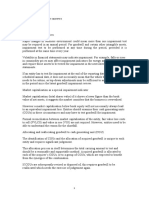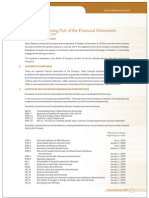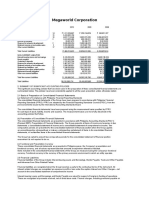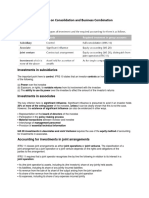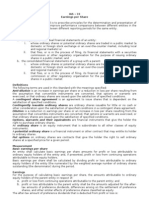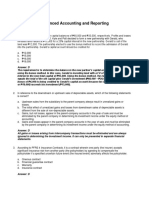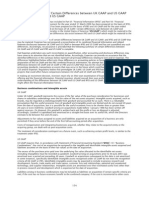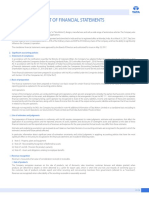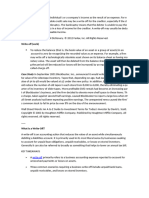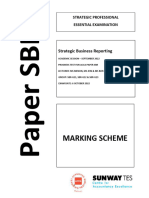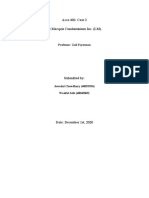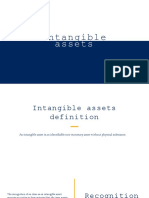United States Generally Accepted Accounting Principles
United States Generally Accepted Accounting Principles
Uploaded by
Akshay JiremaliCopyright:
Available Formats
United States Generally Accepted Accounting Principles
United States Generally Accepted Accounting Principles
Uploaded by
Akshay JiremaliOriginal Description:
Original Title
Copyright
Available Formats
Share this document
Did you find this document useful?
Is this content inappropriate?
Copyright:
Available Formats
United States Generally Accepted Accounting Principles
United States Generally Accepted Accounting Principles
Uploaded by
Akshay JiremaliCopyright:
Available Formats
United States Generally Accepted Accounting Principles
The group's consolidated nancial statements are prepared in accordance with accounting principles generally accepted in
the UK (UK GAAP), which differ in certain respects from those applicable in the US (US GAAP).
I Differences between United Kingdom and United States generally accepted accounting principles
The following are the main differences between UK and US GAAP which are relevant to the group's nancial statements.
(a) Sale and leaseback of properties
Under UK GAAP, the sale of BT's property portfolio is treated as a xed asset disposal and the subsequent leaseback is an
operating lease. Under US GAAP, the transaction is regarded as ``nancing'' and the land and buildings are recorded on
the balance sheet at their net book value, an obligation equivalent to the cash proceeds is recognised and the gain on
disposal is deferred until the properties are vacated by BT. Rental payments made by BT are reversed and replaced by a
nance lease interest charge and a depreciation charge.
(b) Pension costs
Under UK GAAP, pension costs are accounted for in accordance with UK Statement of Standard Accounting Practice
No. 24, costs being charged against prots over employees' working lives. Under US GAAP, pension costs are determined
in accordance with the requirements of US Statements of Financial Accounting Standards (SFAS) Nos. 87 and 88.
Differences between the UK and US GAAP gures arise from the requirement to use different actuarial methods and
assumptions and a different method of amortising surpluses or decits.
(c) Accounting for redundancies
Under UK GAAP, the cost of providing incremental pension benets in respect of workforce reductions is taken into
account when determining current and future pension costs, unless the most recent actuarial valuation, combined with the
provision for pension costs in the group balance sheet, under UK actuarial conventions, shows a decit. In this case, the
cost of providing incremental pension benets is included in redundancy charges in the year in which the employees agree
to leave the group.
Under US GAAP, the associated costs of providing incremental pension benets are charged against prots in the
period in which the termination terms are agreed with the employees.
(d) Capitalisation of interest
Under UK GAAP, the group does not capitalise interest in its nancial statements. To comply with US GAAP, the estimated
amount of interest incurred whilst constructing major capital projects is included in xed assets, and depreciated over the
lives of the related assets. This included capitalisation of interest incurred on funding the 3G licences up to the date of the
demerger. The amount of interest capitalised is determined by reference to the average interest rates on outstanding
borrowings. At 31 March 2002 under US GAAP, gross capitalised interest of 330 million (2001 692 million) with regard
to the company and its subsidiary companies was subject to depreciation generally over periods of three to 25 years.
(e) Goodwill
Under UK GAAP, in respect of acquisitions completed prior to 1 April 1998, the group wrote off goodwill arising from the
purchase of subsidiary undertakings, associates and joint ventures on acquisition against retained earnings. The goodwill is
reected in the net income of the period of disposal, as part of the calculation of the gain or loss on divestment. Under
US GAAP, such goodwill is held as an intangible asset in the balance sheet and amortised over its useful life and only the
unamortised portion is included in the gain or loss recognised at the time of divestment. Gross goodwill under US GAAP at
31 March 2002 of 675 million (2001 10,309 million) was subject to amortisation over periods of three to 20 years. The
value of goodwill is reviewed annually and the net asset value is written down if a permanent diminution in value has
occurred. When impairment indicators exist, goodwill impairment is measured by discounting future projected cashows or
using quoted market prices if available.
(f) Mobile cellular telephone licences, software and other intangible assets
Certain intangible xed assets recognised under US GAAP purchase accounting requirements are subsumed within
goodwill under UK GAAP. Under US GAAP these separately identied intangible assets are valued and amortised over their
useful lives.
(g) Financial instruments
Under UK GAAP, investments are held on the balance sheet at historical cost, and own shares held in trust for share
schemes are recorded in xed asset investments. Gains and losses on instruments used for hedges are not recognised
until the exposure being hedged is recognised. Under US GAAP, trading securities and available-for-sale securities are
128 BT Group Annual Report and Form 20-F 2002
United States Generally Accepted Accounting Principles
I Differences between United Kingdom and United States generally accepted accounting principles continued
carried at market value with appropriate valuation adjustments recorded in prot and loss and shareholders' equity,
respectively. Certain derivative nancial instruments which qualify as hedge accounting under UK GAAP do not qualify for
hedge accounting under US GAAP.
These nancial instruments, under US GAAP, are carried at market value with valuation adjustments recorded in prot
and loss. Own shares held in trust are treated as a reduction to shareholders' equity until they are reissued to employees.
The reassessment and purchase of derivatives in the year ended 31 March 2002 gave rise to an adjustment reducing net
income by 20 million (2001 93 million). The net unrealised holding gain on available-for-sale securities for the year
ended 31 March 2002 was 271 million (2001 8 million, 2000 311 million). SFAS 133 became effective for BT on
1 April 2001 and a transitional adjustment on adoption of 46 million net of tax has been recorded in shareholders' equity.
(h) Deferred gain
Under UK GAAP, assets contributed to a joint venture by the group's partners are measured at their net replacement cost.
Any difference between the group's share of the joint venture's resulting net assets and the net book value of assets
contributed by the group to the joint venture, including certain accrued start up costs, is immediately reected by adjusting
the group's investment in the joint venture and recording a deferred difference in shareholders' equity. Under US GAAP, the
assets contributed by all joint venture partners are carried at their historical net book value and any difference between the
group's share of the joint venture's resulting net assets and the net book value of assets contributed by the group to the
joint venture is amortised over the life of the items giving rise to the difference.
(i) Employee share plans
Certain share options have been granted under BT save-as-you-earn plans at a 20% discount. Under UK GAAP, the share
issues are recorded at their discounted price when the options are exercised. Under US GAAP, a plan is considered
compensatory when the discount to market price is in excess of 15%. Compensation cost is recognised for the difference
between the exercise price of the share options granted and the quoted market price of the shares at the date of grant or
measurement date and accrued over the vesting period of the options.
Under UK GAAP, shares held by employee share ownership trusts are recorded as xed asset investments at cost less
amounts written off. Under US GAAP, those shares not fully vested are regarded as treasury stock and recorded at cost as
a deduction from shareholders' equity.
(j) Investments in associates
Under UK GAAP, the group records the share of operating prot and loss of ventures based upon the total interest in the
venture based upon the consolidation structure. The group records the equity in the operations of the venture on the basis
of its consolidated results excluding the holdings of any of the group's other ventures for the purpose of determining the
economic interest. The share of the operations of the ventures is reduced to the economic interest through an increase to
minority interests at the group level. Under US GAAP, the share of the operating results of the venture is recorded at the
amount of the group's economic interest.
(k) Deferred taxation
Following the introduction of FRS 19, under UK GAAP, provision is made for deferred tax in so far as a liability or asset
arose as a result of transactions that had occurred by the balance sheet date and give rise to an obligation to pay more tax
in the future, or a right to pay less tax in the future. Under US GAAP, deferred taxation is provided for on a full liability basis.
(l) Dividends
Under UK GAAP, dividends are recorded in the year in respect of which they are declared (in the case of interim or any
special dividends) or proposed by the board of directors to the shareholders (in the case of nal dividends). Under
US GAAP, dividends are recorded in the period in which dividends are declared.
(m) Impairment
Under UK GAAP, if there is an indication of impairment the assets should be tested for impairment and, if necessary written
down to the value in use, calculated based on discounted future pre-tax cash ows related to the asset or the income
generating unit to which the asset belongs.
US GAAP requires that an entity assess whether impairment has occurred based on the undiscounted future cash
ows. An impairment loss exists if the sum of these cash ows is less than the carrying amount of the asset. The
impairment loss recognised in the income statement is based on the asset's fair value, being either market value or the sum
of discounted future cash ows.
BT Group Annual Report and Form 20-F 2002 129
United States Generally Accepted Accounting Principles
I Differences between United Kingdom and United States generally accepted accounting principles continued
(n) Discontinued operations
Under UK GAAP, the disposal of certain lines of business and joint ventures and associates are shown as discontinued
activities. Under US GAAP, only the disposals of lines of business under Accounting Principles Board (APB) Opinion No. 30
would be reported as discontinued operations.
(o) Directories in progress
Under UK GAAP, the cost of classied advertising directories in progress deferred in stock represents direct xed and
variable costs as well as directly attributable overhead costs. Under US GAAP, the deferred costs associated with
directories in progress comprise only the incremental direct costs associated with selling and creating the directories.
Directories in progress acquired in a business purchase are valued at replacement value under UK GAAP and at retail value
under US GAAP. Under UK GAAP, this difference is included in goodwill.
(p) Disposals of businesses
There are timing differences between UK GAAP and US GAAP for recognition of gains on the sale of certain businesses.
Foreign exchange movements taken to reserves under UK GAAP are reported in the income statement under US GAAP.
Historical GAAP differences on disposed businesses are also shown under this line item.
II Net income and shareholders' equity reconciliation statements
The following statements summarise the material estimated adjustments, gross of their tax effect, which reconcile net
income and shareholders' equity from that reported under UK GAAP to that which would have been reported had US GAAP
been applied.
Net income 2002 2001 2000
Years ended 31 March m m m
Net income (loss) applicable to shareholders under UK GAAP 995 (1,870) 1,995
Restatement for deferred tax under FRS 19 60 60
Net income (loss) applicable to shareholders under UK GAAP as previously reported 995 (1,810) 2,055
Adjustment for:
Sale and leaseback of properties (1,178)
Pension costs (106) (42) (209)
Redundancy charges (140) (453) (300)
Capitalisation of interest, net of related depreciation 398 348 (14)
Goodwill amortisation (34) (55) (64)
Mobile licences, software and other intangible asset capitalisation and
amortisation, net (32) (32) (33)
Financial instruments 23 (133) (129)
Deferred gain 313 (71) (19)
Impairment 192
Employee share plans (8) (38)
Deferred taxation (1,409) 11 106
Directories in progress (82)
Disposals of businesses 254
Net income (loss) as adjusted for US GAAP (732) (2,357) 1,393
a
Basic earnings (loss) per American Depositary Share as adjusted for US GAAP (0.88) (3.24) 1.93
Diluted earnings (loss) per American Depositary Share as adjusted for US GAAPa (0.88) (3.24) 1.88
a
Each American Depositary Share is equivalent to 10 ordinary shares.
The adjustments to net income relating to discontinued operations are 282 million (2001 276 million, 2000 18 million
loss).
130 BT Group Annual Report and Form 20-F 2002
United States Generally Accepted Accounting Principles
II Net income and shareholders' equity reconciliation statements continued
Shareholders' equity 2002 2001
At 31 March m m
Shareholders' equity under UK GAAP (358) 12,054
Restatement for deferred tax under FRS 19 2,015
Shareholders equity under UK GAAP as previously reported (358) 14,069
Adjustment for:
Sale and leaseback of properties (1,178)
Pension costs (3,003) (2,755)
Redundancy costs (25)
Capitalisation of interest, net of related depreciation 250 620
Goodwill, net of accumulated amortisation 141 122
Mobile licences, software and other intangible asset capitalisation and amortisation 482 521
Financial instruments (592) (620)
Deferred gain (323)
Impairment 192
Deferred taxation (474) (1,296)
Directories in progress (82)
Disposals of businesses 120
Dividend declared after the nancial year end 173
Shareholders' equity as adjusted for US GAAP (4,247) 10,231
III Minority interests
Under US GAAP, the income to minority interests would have been reduced by 26 million (2001 income reduced by
122 million, 2000 loss increased by 10 million) after adjusting for goodwill amortisation and accounting for associates
and joint ventures. Net assets attributable to minority interests would have been 26 million higher (2001 32 million
higher) after adjusting for nancial instruments.
IV Accounting for share options
Under UK GAAP, the company does not recognise compensation expense for the fair value, at the date of grant, of share
options granted under the employee share option schemes. Under US GAAP, the company adopted the disclosure-only
option in SFAS No. 123 ``Accounting for Stock-Based Compensation''. Accordingly, the company accounts for share
options in accordance with APB Opinion No. 25 ``Accounting for Stock Issued to Employees'', under which no
compensation expense is recognised. Had the group expensed compensation cost for options granted in accordance with
SFAS No. 123, the group's pro forma net income (loss), basic earnings (loss) per share and diluted earnings (loss) per share
under US GAAP would have been (792) million loss (2001 (2,419) million loss, 2000 1,347 million prot), (9.5)p loss
(2001 (33.2)p loss, 2000 18.6p) and (9.5)p loss (2001 (33.2)p loss, 2000 18.2p), respectively. The SFAS No. 123
method of accounting does not apply to share options granted before 1 January 1995, and accordingly, the resulting pro
forma compensation costs may not be representative of that to be expected in future years. See note 34 for the SFAS
No. 123 disclosures of the fair value of options granted under employee schemes at date of grant.
V Consolidated statements of cash ows
Under UK GAAP, the Consolidated Statements of Cash Flows are presented in accordance with UK Financial Reporting
Standard No. 1 (FRS 1). The statements prepared under FRS 1 present substantially the same information as that required
under SFAS No. 95.
Under SFAS No. 95 cash and cash equivalents include cash and short-term investments with original maturities of three
months or less. Under FRS 1 cash comprises cash in hand and at bank and overnight deposits, net of bank overdrafts.
Under FRS 1, cash ows are presented for operating activities; returns on investments and servicing of nance;
taxation; capital expenditure and nancial investments; acquisitions and disposals; dividends paid to the company's
shareholders; management of liquid resources and nancing. SFAS No. 95 requires a classication of cash ows as
resulting from operating, investing and nancing activities.
Cash ows under FRS 1 in respect of interest received, interest paid (net of that capitalised under US GAAP) and
taxation would be included within operating activities under SFAS No. 95. Cash ows from purchases, sales and maturities
of trading securities, while not separately identied under UK GAAP, would be included within operating activities under
US GAAP. Capitalised interest, while not recognised under UK GAAP, would be included in investing activities under
US GAAP. Dividends paid would be included within nancing activities under US GAAP.
BT Group Annual Report and Form 20-F 2002 131
United States Generally Accepted Accounting Principles
V Consolidated statements of cash ows continued
The following statements summarise the statements of cash ows as if they had been presented in accordance with
US GAAP, and include the adjustments which reconcile cash and cash equivalents under US GAAP to cash at bank and in
hand reported under UK GAAP.
2002 2001 2000
m m m
Net cash provided by operating activities 1,455 5,515 4,003
Net cash used in investing activities 3,049 (22,785) (9,104)
Net cash provided by (used in) nancing activities (5,611) 18,311 4,697
Net increase (decrease) in cash and cash equivalents (1,107) 1,041 (404)
Effect of exchange rate changes on cash (50) (15) (1)
Cash and cash equivalents under US GAAP at beginning of year 2,281 1,255 1,660
Cash and cash equivalents under US GAAP at end of year 1,124 2,281 1,255
Short-term investments with original maturities of less than three months (966) (1,869) (1,002)
Cash at bank and in hand under UK GAAP at end of year 158 412 253
VI Current asset investments
Under US GAAP, investments in debt securities would be classied as either trading, available-for-sale or held-to-maturity.
Trading investments would be stated at fair values and the unrealised gains and losses would be included in income.
Securities classied as available-for-sale would be stated at fair values, with unrealised gains and losses, net of deferred
taxes, reported in shareholders' equity. Debt securities classied as held-to-maturity would be stated at amortised cost.
The following analyses do not include securities with original maturities of less than three months.
At 31 March 2002, the group held trading investments (as dened by US GAAP) at a carrying amount of 1,245 million
(2001 390 million) with fair values totalling 1,260 million (2001 394 million). Held-to-maturity securities at 31 March
2001 and 2002 consisted of the following:
Amortised Estimated
cost fair value
m m
Commercial paper, medium-term notes and other investments 2,372 2,372
Total at 31 March 2002 2,372 2,372
UK Government securities and other UK listed investments 8 8
Commercial paper, medium-term notes and other investments 30 30
Total at 31 March 2001 38 38
The contractual maturities of the held-to-maturity debt securities at 31 March 2002 were as follows:
Cost Fair value
m m
Maturing on or before 31 March 2003 2,370 2,370
Maturing after 31 March 2003 2 2
Total at 31 March 2002 2,372 2,372
VII Pension costs
The following position for the main pension scheme is computed in accordance with US GAAP pension accounting rules
under SFAS No. 87 and SFAS No. 88, the effect of which is shown in the above reconciliation statements.
The pension cost determined under SFAS No. 87 was calculated by reference to an expected long-term rate of return
on scheme assets of 6.5% (2001 6.25%, 2000 6.5%). The components of the pension cost for the main pension
scheme comprised:
2002 2001 2000
m m m
Service cost 564 580 498
Interest cost 1,739 1,673 1,459
Expected return on scheme assets (1,863) (1,850) (1,600)
Amortisation of prior service costs 24 24 24
Amortisation of net obligation at date of limited application of SFAS No. 87 52 52 52
Recognised gains (67) (133) (65)
Additional cost of termination benets 140 349 263
Pension cost for the year under US GAAP 589 695 631
132 BT Group Annual Report and Form 20-F 2002
United States Generally Accepted Accounting Principles
VII Pension costs continued
The information required to be disclosed in accordance with SFAS No. 132 concerning the funded status of the main
scheme at 31 March 2001 and 31 March 2002, based on the valuations at 1 January 2001 and 1 January 2002,
respectively, is given below.
Changes in benet obligation 2002 2001
m m
Benet obligation at the beginning of the year 31,184 31,024
Service cost 564 580
Interest cost 1,739 1,673
Employees' contributions 180 183
Additional cost of termination benets 140 349
Actuarial movement (3,428) (1,342)
Other changes 27 31
Benets paid or payable (1,309) (1,314)
Benet obligation at the end of the year 29,097 31,184
Changes in scheme assets 2002 2001
m m
Fair value of scheme assets at the beginning of the year 29,031 29,876
Actual return on scheme assets (2,355) (350)
Employers' contributionsa 1,023 605
Employees' contributions 180 183
Other changes 27 31
Benets paid or payable (1,309) (1,314)
Fair value of scheme assets at the end of the year 26,597 29,031
Funded status under US GAAP 2002 2001
m m
Projected benet obligation in excess of scheme assets (2,500) (2,153)
Unrecognised net obligation at date of initial application of SFAS No. 87b 54 106
Unrecognised prior service costsc 127 151
Other unrecognised net actuarial gains (324) (1,181)
Accrued pension costs under US GAAP (2,643) (3,077)
a
The employers' contributions for the year ended 31 March 2002 includes special contributions of 300 million paid on 21 November 2001 and 300 million
paid on 4 December 2001 (2001 200 million paid on 21 December 2000 and 100 million paid on 30 March 2001).
b
The unrecognised net obligation at the date of initial application is being amortised over 15 years from 1 April 1988.
c
Unrecognised prior service costs on scheme benet improvements are being amortised over periods of 15 or 16 years commencing in the years of the
introduction of the improvements.
The benet obligation for the main pension scheme was determined using the following assumptions at 1 January 2001
and 1 January 2002:
2002 2001
per annum per annum
% %
Discount rate 6.0 5.7
Rate of future pay increases 4.0 4.8
Rate of future pension increases 2.5 3.0
The accumulated benet obligation at 31 March 2002 was 27,127 million (2001 28,694 million).
BT Group Annual Report and Form 20-F 2002 133
You might also like
- Modern Advanced Accounting 8e Chapter 10 Solution ManualDocument54 pagesModern Advanced Accounting 8e Chapter 10 Solution ManualAnthony Sanchez82% (11)
- ASC Research Case-Defensive Intangible AssetDocument2 pagesASC Research Case-Defensive Intangible AssetJoey LessardNo ratings yet
- Balance Sheet & Income Statement For Hospital PDFDocument45 pagesBalance Sheet & Income Statement For Hospital PDFAdrianus PramudhitaNo ratings yet
- BPP Revision Kit Sample Answers 1Document8 pagesBPP Revision Kit Sample Answers 1Kian Tuck0% (1)
- IAS 18 - Revenue PDFDocument12 pagesIAS 18 - Revenue PDFJanelle SentinaNo ratings yet
- Notes To The Company Accounts: 37 Accounting PoliciesDocument7 pagesNotes To The Company Accounts: 37 Accounting PoliciesManu KmrNo ratings yet
- IFRS AND IAS of AuditDocument11 pagesIFRS AND IAS of AuditAvinash KumarNo ratings yet
- Lobrigas - Week3 Ia3Document39 pagesLobrigas - Week3 Ia3Hensel SevillaNo ratings yet
- Notes To and Forming Part of The Financial Statements: For The Year Ended June 30, 2009Document26 pagesNotes To and Forming Part of The Financial Statements: For The Year Ended June 30, 2009Sohail Humayun KhanNo ratings yet
- Megaworld Corporation: Liabilities and Equity 2010 2009 2008Document9 pagesMegaworld Corporation: Liabilities and Equity 2010 2009 2008Owdray CiaNo ratings yet
- Vdocuments - MX - Chapter 5 578590693cc3a PDFDocument43 pagesVdocuments - MX - Chapter 5 578590693cc3a PDFAmrita TamangNo ratings yet
- Disclosure of Accounting PoliciesDocument17 pagesDisclosure of Accounting PoliciesarthurenjuNo ratings yet
- Schedule - Specimen of Statement of Significant Accounting PoliciesDocument16 pagesSchedule - Specimen of Statement of Significant Accounting Policiesav_meshramNo ratings yet
- Digiwire, Symbal CoDocument10 pagesDigiwire, Symbal CoAdilah AzamNo ratings yet
- Accounting Policies - Study Group 4IDocument24 pagesAccounting Policies - Study Group 4ISatish Ranjan PradhanNo ratings yet
- Important Notes For Consolidation and Business CombinationDocument10 pagesImportant Notes For Consolidation and Business CombinationSajib Kumar DasNo ratings yet
- JanneDocument20 pagesJanneAdilah AzamNo ratings yet
- Partnership Agreement 2024Document5 pagesPartnership Agreement 2024bmofficial275No ratings yet
- Date: 2009.03.31. Accounting Policies: Chambal Fertilisers & Chemicals LTDDocument14 pagesDate: 2009.03.31. Accounting Policies: Chambal Fertilisers & Chemicals LTDJayverdhan TiwariNo ratings yet
- Trang 248Document4 pagesTrang 248Tran Hoang Dong AnhNo ratings yet
- Ias - 33Document4 pagesIas - 33Asad TahirNo ratings yet
- M6 - Deductions P3 (13B) Students'Document56 pagesM6 - Deductions P3 (13B) Students'micaella pasionNo ratings yet
- Summary of Ifrs 3Document5 pagesSummary of Ifrs 3anon-233437No ratings yet
- Notes To The Financial Statements 30 JUNE 2005: 1. Corporate InformationDocument48 pagesNotes To The Financial Statements 30 JUNE 2005: 1. Corporate InformationJames WarrenNo ratings yet
- Week 5 Intra Group Transaction Tut 29Document11 pagesWeek 5 Intra Group Transaction Tut 29joehe2625No ratings yet
- Draft Financial Reporting Format For Insurance CompaniesDocument37 pagesDraft Financial Reporting Format For Insurance CompaniesmakewayogNo ratings yet
- 6 AfarDocument24 pages6 AfarJM SonidoNo ratings yet
- Chap012 2Document125 pagesChap012 2Aai NurrNo ratings yet
- Textbook SolutionDocument61 pagesTextbook SolutionmmNo ratings yet
- 2.7 Intangible Assets (A) GoodwillDocument8 pages2.7 Intangible Assets (A) GoodwillLolita IsakhanyanNo ratings yet
- Accounting PolicyDocument28 pagesAccounting PolicyAkshay AnandNo ratings yet
- 9 Notes To The Financial Statments NotesDocument36 pages9 Notes To The Financial Statments NotesmohammedaliyyeNo ratings yet
- D Business Combinations - IFRS 3 (Revised)Document10 pagesD Business Combinations - IFRS 3 (Revised)Brook KongNo ratings yet
- IFRS Financials Jun 2014Document25 pagesIFRS Financials Jun 2014Navin KumarNo ratings yet
- Ias-33 EpsDocument59 pagesIas-33 Epssyed asim shahNo ratings yet
- Financial Analysis of Berger PaintsDocument8 pagesFinancial Analysis of Berger PaintsArun PrasadNo ratings yet
- Nykaa E Retail Mar 19Document23 pagesNykaa E Retail Mar 19NatNo ratings yet
- EFU Accounting PoliciesDocument9 pagesEFU Accounting PoliciesJaved AkramNo ratings yet
- SMEs SummaryDocument10 pagesSMEs SummaryGloria BeltranNo ratings yet
- Part9summary of Certain Differences Between UK GAAP and US GAAP and IFRS and US GAAPDocument11 pagesPart9summary of Certain Differences Between UK GAAP and US GAAP and IFRS and US GAAPZainab TehzeebNo ratings yet
- Tata Motors Notes Forming Part of Financial StatementsDocument36 pagesTata Motors Notes Forming Part of Financial StatementsSwarup RanjanNo ratings yet
- G. Property, Plant and EquipmentDocument5 pagesG. Property, Plant and EquipmentLalalaNo ratings yet
- Chapter 08Document26 pagesChapter 08sdnm dnkNo ratings yet
- SBR Assigment-Liam'sDocument7 pagesSBR Assigment-Liam'sbuls eyeNo ratings yet
- SBR TutorialsDocument11 pagesSBR TutorialskityanNo ratings yet
- LERIADocument3 pagesLERIAtontoto1221No ratings yet
- Ias 12 IeDocument45 pagesIas 12 IeCatalin BlesnocNo ratings yet
- Description of The Account Based On The San Miguel CorporationDocument5 pagesDescription of The Account Based On The San Miguel CorporationMARRIETTE JOY ABADNo ratings yet
- TataDocument56 pagesTataAndreea GeorgianaNo ratings yet
- PWC Partnership IPODocument9 pagesPWC Partnership IPOAnonymous fjgmbzTNo ratings yet
- F3 02 SCI and SCE HandoutsDocument7 pagesF3 02 SCI and SCE HandoutsRichard de LeonNo ratings yet
- Write Off - Translation Reserve - Rdos Acumulados - Rdos No Asig y Reservas - Equity-Accounted Investees Vs Non-Controlling Interest - InvestigaciónDocument9 pagesWrite Off - Translation Reserve - Rdos Acumulados - Rdos No Asig y Reservas - Equity-Accounted Investees Vs Non-Controlling Interest - InvestigaciónignaciopasquinelliNo ratings yet
- Marking Scheme: Strategic Business ReportingDocument11 pagesMarking Scheme: Strategic Business Reportingamy najatNo ratings yet
- Plugin Ifrs Investment Funds Issue 1b 686Document0 pagesPlugin Ifrs Investment Funds Issue 1b 686xuhaibimNo ratings yet
- Unit II Consolidated Financial Statements Date of AcquisitionDocument17 pagesUnit II Consolidated Financial Statements Date of AcquisitionDaisy TañoteNo ratings yet
- Chapter 17 Investments in Stocks and Bonds: Aggregate Securities (E.g. One For Trading and One ForDocument16 pagesChapter 17 Investments in Stocks and Bonds: Aggregate Securities (E.g. One For Trading and One ForBrian BlackNo ratings yet
- Ifrs 31Document5 pagesIfrs 31John Rey Batandolo ManatadNo ratings yet
- Fac 302 ProjectDocument10 pagesFac 302 ProjectGrace GabrielNo ratings yet
- What Is A Financial InstrumentDocument9 pagesWhat Is A Financial InstrumentSimon ChawingaNo ratings yet
- NOTES 12 InterimDocument6 pagesNOTES 12 InterimWinny PoeNo ratings yet
- Corporate Reporting (International) : P2CR-MT2A-X09-A Answers & Marking SchemeDocument11 pagesCorporate Reporting (International) : P2CR-MT2A-X09-A Answers & Marking SchemeKyaw Htin WinNo ratings yet
- Partnerships 1Document6 pagesPartnerships 1ogenrwotronald10No ratings yet
- Chapter-3: An Overview of ForwardDocument57 pagesChapter-3: An Overview of ForwardAkshay JiremaliNo ratings yet
- Pest Analysis of Tire IndustryDocument14 pagesPest Analysis of Tire IndustryAkshay Jiremali100% (1)
- Narmada College of Management - A Budget of The Orientation ProgramDocument2 pagesNarmada College of Management - A Budget of The Orientation ProgramAkshay JiremaliNo ratings yet
- Narmada College of Management - 737: Zadeshwar, Bharuch - 392011Document1 pageNarmada College of Management - 737: Zadeshwar, Bharuch - 392011Akshay JiremaliNo ratings yet
- An Evaluation of Organization Development InterventionsDocument6 pagesAn Evaluation of Organization Development InterventionsAkshay JiremaliNo ratings yet
- About Bearings: Machine Element Friction Moving Parts Linear Rotation Around A Fixed Axis Vectors Normal ForcesDocument3 pagesAbout Bearings: Machine Element Friction Moving Parts Linear Rotation Around A Fixed Axis Vectors Normal ForcesAkshay JiremaliNo ratings yet
- Idp Report (Dharmishta)Document36 pagesIdp Report (Dharmishta)Akshay JiremaliNo ratings yet
- MBA ReportDocument100 pagesMBA ReportAkshay JiremaliNo ratings yet
- MCQ Sem I - 1Document4 pagesMCQ Sem I - 1Akshay JiremaliNo ratings yet
- Cost AssignmentDocument12 pagesCost AssignmentAkshay JiremaliNo ratings yet
- 11 ModB LinearProgDocument32 pages11 ModB LinearProgAkshay Jiremali100% (1)
- Literature ReviewDocument33 pagesLiterature ReviewAkshay JiremaliNo ratings yet
- Literature ReviewDocument73 pagesLiterature ReviewAkshay JiremaliNo ratings yet
- Gujarat Technological University: Mba - Semester-Ii Examination - Summer - 2017Document5 pagesGujarat Technological University: Mba - Semester-Ii Examination - Summer - 2017Akshay JiremaliNo ratings yet
- SIP Report On ONGC (Neha)Document100 pagesSIP Report On ONGC (Neha)Akshay JiremaliNo ratings yet
- Sip Project On Employee Absenteesim (Final)Document95 pagesSip Project On Employee Absenteesim (Final)Akshay JiremaliNo ratings yet
- Mark A. DwamenaDocument82 pagesMark A. DwamenaAkshay JiremaliNo ratings yet
- Sip Zudus PerformanceDocument104 pagesSip Zudus PerformanceAkshay Jiremali100% (1)
- THE AUDIT PROCESS Verication of AssetsDocument17 pagesTHE AUDIT PROCESS Verication of AssetsmavhikalucksonprofaccNo ratings yet
- Full PFRS and PFRS For SMEsDocument6 pagesFull PFRS and PFRS For SMEsChristine Joyce MagoteNo ratings yet
- Case 2 - Acco 420Document7 pagesCase 2 - Acco 420Wasif SethNo ratings yet
- Quiz 5Document7 pagesQuiz 5shivnilNo ratings yet
- Accounting For Depreciation Accounting For DepreciationDocument32 pagesAccounting For Depreciation Accounting For DepreciationKaranNo ratings yet
- Midterm ExaminationDocument9 pagesMidterm ExaminationJohn Francis RosasNo ratings yet
- Chapter 4: Accounting Analysis: Accounting AdjustmentsDocument8 pagesChapter 4: Accounting Analysis: Accounting AdjustmentsPia RiNo ratings yet
- p1 & AP - IntangiblesDocument13 pagesp1 & AP - IntangiblesJolina Mancera100% (3)
- Revised Syllabus of BS Commerce 2017Document87 pagesRevised Syllabus of BS Commerce 2017ahsan azizNo ratings yet
- Theory QuestionsDocument5 pagesTheory Questionsjhobs100% (1)
- Financial Accounting TheoryDocument14 pagesFinancial Accounting Theoryjustine reine cornicoNo ratings yet
- F7 Acowtancy Notes PDFDocument183 pagesF7 Acowtancy Notes PDFwaleed zahoorNo ratings yet
- PAINEL 1 - Transfer Pricing & IntangiblesDocument20 pagesPAINEL 1 - Transfer Pricing & Intangiblesedson souzaNo ratings yet
- Lecture 5 - 1oct13Document56 pagesLecture 5 - 1oct13Ifzal AhmadNo ratings yet
- Financial Accounting II - MGT401 Spring 2012 Mid Term Solved QuizDocument21 pagesFinancial Accounting II - MGT401 Spring 2012 Mid Term Solved Quizsania.mahar0% (1)
- 1 Intangible Assets PDFDocument56 pages1 Intangible Assets PDFCatherine RiveraNo ratings yet
- Comprehensive Topics With AnsDocument28 pagesComprehensive Topics With AnsHaru Lee60% (5)
- Bab 5 Analisis Laporan KeuanganDocument54 pagesBab 5 Analisis Laporan KeuanganBenedict MihoyoNo ratings yet
- Chapter 11Document3 pagesChapter 11Kristine TiuNo ratings yet
- Module 4 Preparing The Financial Statements: Statement of Financial PositionDocument20 pagesModule 4 Preparing The Financial Statements: Statement of Financial PositionErine Contrano100% (3)
- EpfoDocument6 pagesEpfoSiddharth OjhaNo ratings yet
- Intangible AssetDocument12 pagesIntangible AssetSha iyyaahNo ratings yet
- 1 Asset AccountsDocument3 pages1 Asset Accountsapi-299265916No ratings yet
- Position Paper On Accounting For GoodwillDocument36 pagesPosition Paper On Accounting For GoodwillNica PSNo ratings yet
- Financial Accounting WorkBook ICMRDocument368 pagesFinancial Accounting WorkBook ICMRSarthak Gupta75% (4)
- NESTLEDocument141 pagesNESTLENataly Abanto VasquezNo ratings yet
- Quiz - Intangible Assets With QuestionsDocument3 pagesQuiz - Intangible Assets With Questionsjanus lopezNo ratings yet



